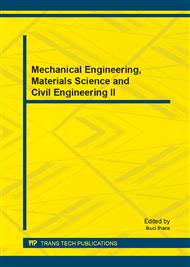[1]
Liu Jiancui. Energy saving potential and carbon emissions prediction for the transportation sector in China. Resources science, 2011, 33(4): 640-646.
Google Scholar
[2]
No. 195 document. Special plan for the development of electric automobile in the 12th Five-Year-Plan period. The Ministry of Science and Technology of the People's Repubic of China, (2012).
Google Scholar
[3]
Zhang Wenliang, Wu Bin, Li Wufeng, et al. Discussion on development trend of battery electric vehicles in China and its energy supply mode. Power system technology, 2009, 33(4): 1-5.
Google Scholar
[4]
Song Yonghua, Yang Yuexi, Hu Zechun. Present status and development trend of batteries for electric vehicles. Power system technology, 2011, 35(4): 1-7.
Google Scholar
[5]
Zeng Ming, Xue Song, Liu Hongzhi, et al. Research on regional vehicle-to-grid operation mode and optimal share planning model integrating it into electric power system. Power system technology, 2012, 36(6): 175-181.
Google Scholar
[6]
Du Aihu, Hu Zechun, Song Yonghua, et al. Distribution network planning considering layout optimization of electric vehicle charging stations. Power system technology, 2011, 35(11): 36-42.
DOI: 10.1109/powercon.2014.6993928
Google Scholar
[7]
Guo Wen shuang, Shen Jin sheng, Xu Yifei. Comparison of environmental indexes between electric vehicles and fuel vehicles. Environmental protection in transportation, 2002, 35(2): 21-30.
Google Scholar
[8]
Ren Yulong, Li Haifeng, Sun Rui, et al. Analysis on Model of Life Cycle Cost of Electric Vehicle Based on Consumer Perspective. Technology economics, 2009, 28(11): 54-58.
Google Scholar
[9]
Jin Yonghua, Li Xiangjun. Economic analysis of new energy vehicles based on PHEV and BEV of BYD. Renewable energy, 2012, 30(6): 118-126.
Google Scholar
[10]
Xiao Bin, Zhang A-ling, Chen Gui-feng. Life cycle inventory of clean coal-fired power generation in China. Clean coal technology, 2005, 11(2): 1-4.
Google Scholar
[11]
Yao Meihong, Liu Jianxia, Lin Hongqi. The Controlling technology of diesel engine discharged NOx. Journal of Agricultural mechanization research, 2008, 24(11): 200-203.
Google Scholar
[12]
Kang Chongqing, Zhou Tianrui, Chen Qixin, et al. Assessment model on low-carbon effects of power grid and its application. Power system technology, 2009, 33(17): 1-6.
DOI: 10.1109/powercon.2012.6401256
Google Scholar


